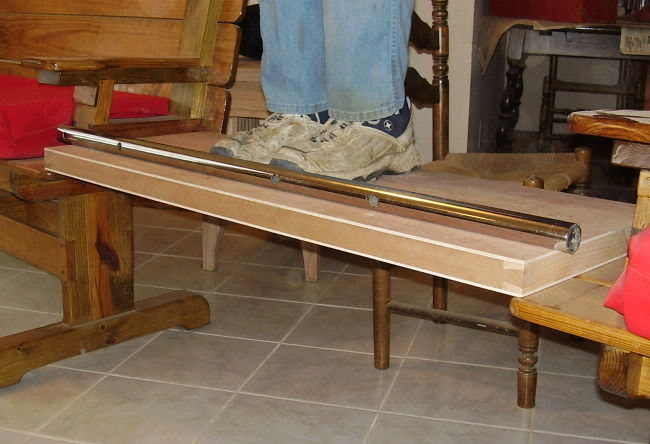Posts: 22,134
Threads: 0
Joined: Nov 2002
I made a few of these awhile back. Torsion boxes make super-strong shelves:
Here's how strong they are:
I weigh 190 lb. See any bend?
Rip to width. Plane to thickness. Cut to length. Join.
Posts: 22,134
Threads: 0
Joined: Nov 2002
BTW, these shelves are about 80% hollow. They hardly weigh anything at all. I used ordinary 1/4" plywood for the surfaces. I have never understood exactly why they are so strong, but they are. The corner joint connections (dove tails) don't add much strength, if any. I was just practicing when I made them.
Rip to width. Plane to thickness. Cut to length. Join.
Posts: 1,278
Threads: 0
Joined: Sep 2012
Location: Mobile, Alabama
01-05-2023, 04:58 PM
(This post was last modified: 01-05-2023, 05:06 PM by Willyou.)
Nicely done. A slightly narrower version of that makes an excellent planer sled too. Flat, stiff, and light,
Bending forces on a plank are greatest along the surfaces. Almost zero along the center line. Torsion boxes are so strong relative to the weight because the strongest components, the plywood, are on the faces and separated by the distance between them. The greater that distance (thickness) the greater the strength. The spacers between the two faces are only there to maintain that distance during bending forces.
Posts: 22,134
Threads: 0
Joined: Nov 2002
01-05-2023, 06:51 PM
(This post was last modified: 01-12-2023, 04:15 PM by Edwin Hackleman.)
I also must admit that there is some ladder-step like bracing front-to back every 12" that is needed underneath the plywood panels to add more strength. However, that is small potatoes compared to a solid shelf.
In 10 years, these 48" long torsion box shelves that I made have been loaded and have not even begun to sag. I wish that were the case of the heavy shelves in my storage closets that were installed by the builder of the house. Made of 3/4" particle board, they sag like a hammock, even when supported every 24".
Rip to width. Plane to thickness. Cut to length. Join.
Posts: 2,303
Threads: 0
Joined: Dec 2006
Location: virginia beach VA
Ed, nice work. Torsions boxes are incredibly strong. I made a few years ago, using 1/4 luan for the skins, and a 4 foot section carried a person in their motorized scooter with no problem.
Posts: 1,278
Threads: 0
Joined: Sep 2012
Location: Mobile, Alabama
(01-05-2023, 06:51 PM)Edwin Hackleman Wrote: Made of 3/4" particle board, they sag like a hammock, even when supported every 24".
That's because particle board has very little compressive or tensional strength at the surtaces. All of the compressive strength is perpendicular to the surface because of all of the material underneath has go where to go.
Posts: 22,134
Threads: 0
Joined: Nov 2002
01-06-2023, 01:53 PM
(This post was last modified: 01-06-2023, 02:33 PM by Edwin Hackleman.)
I had a few guys tell me that I wasted my time making those dovetail joints at the corners, specially since I eventually painted these shelf boards off-white to match the cabinet in my shop. I could have simply used a miter or a notched joint. Lots of glue and the staples hold the panels in place. In all, it was a fun project, and I was amazed at the bending strength.

Here's another corner joint I like to use and it would have worked very well also: the Bridle Joint.
Rip to width. Plane to thickness. Cut to length. Join.
Posts: 2,163
Threads: 1
Joined: Sep 2003
Location: Maryland
LOL...15 or 20 years ago I built the David Marks torsion box assembly table. It's about 4.5' square, half inch thick webbing, 3/4 inch facing/skins all in MDF. Good lord that thing is heavy.
Plenty flat, but to move that sucker I have to darn near use a chain hoist to lift it off the sawhorses and lower it to a couple of dollies. So it hasn't moved in 10 years.
Posts: 12,660
Threads: 0
Joined: Jan 2010
Location: Lewiston, NY
Torsion boxes derive their stiffness proportional to the thickness cubed. So a torsion box made with a 2" grid height has 8X the stiffness of one made with a 1" grid. The joinery of the grid is of no significant importance, even butt joints work fine. It's all about the height of the grid and the bond between it and the skins.
John
Posts: 22,134
Threads: 0
Joined: Nov 2002
01-06-2023, 06:55 PM
(This post was last modified: 01-06-2023, 06:57 PM by Edwin Hackleman.)
(01-06-2023, 02:55 PM)joe1086 Wrote: LOL...15 or 20 years ago I built the David Marks torsion box assembly table. It's about 4.5' square, half inch thick webbing, 3/4 inch facing/skins all in MDF. Good lord that thing is heavy.
Plenty flat, but to move that sucker I have to darn near use a chain hoist to lift it off the sawhorses and lower it to a couple of dollies. So it hasn't moved in 10 years.
The thickness and density of the MDF facing/skins caused the massive weight, likely 90% of it. Marks actually specified that thickness? By doing so, he ruined the major objective of torsion box assembly -- a design that yields a light and strong component. I doubt that the shelves I show in Post #1 weigh more than 3 pounds each and maybe even less than that.
Marx was building and assembly table that you could pound on with a sledge hammer. He might as well have used cutting board glue up stock that I often use for workbenches.


Rip to width. Plane to thickness. Cut to length. Join.













